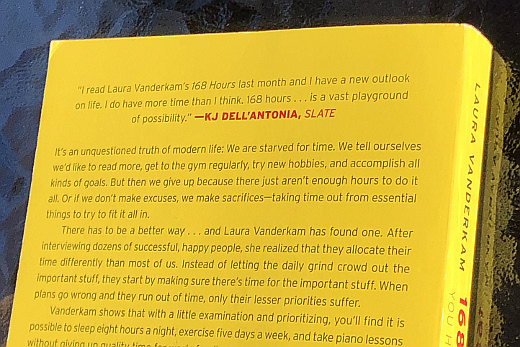My Takeaways From 168 Hours
“There’s not enough time in a day.” It’s a phrase I hear a lot, and one I say myself. A lot. Often the phrase is said at the end of the day, following many things done but with still many more to do. There’s 24 hours in a day, yet people still have a hard time getting done all that we want.
What if we look at it differently, from the point of view of an entire week rather than just a day? Where there’s only 24 hours in one day, there’s 168 hours in a 7-day week. Does it seem more possible to get done with more time? This is the idea behind the book 168 Hours: You Have More Time Than You Think by Laura Vanderkam.
168 Hours is more than just another time management book. It explores the possibilities what you can do when you look at time and tasks differently, what you should do as well as what you could have others do for you. As I read through the advice and stories, a few takeaways came to mind.
Time logging is hard when we don’t block time – I have done time logging before, namely when consulting and tracking my time to bill to clients. I also used the method in the book of tracking all tasks every hour for a week, literally 24/7. Where it gets difficult is when you do multiple things in a time period, say a half hour, and you are not focusing on one thing. Time blocking is something I do as often as I can to dedicate a period of time to one task.
Working on 100 Dreams – So what do you want to do with your new-found time? After realizing you may actually have more time than you thought, the author suggests creating a list of 100 dreams of things you would like to do in your lifetime. This is in itself is an intriguing and sole-searching experience, and is something I am still working on. Vanderkam says that not all of the dreams have to be big, but why not?
15 minute tasks – What if all of the sudden you had 15 minutes to spare without interruption, what would you do? When we think about our to-do’s, we often just see the larger end result of the effort, and not that it is a collection of smaller tasks. This is the idea behind Scrum and how I have been looking at both my work and personal projects since I got my Scrum certification, by breaking a project into smaller tasks and executing them in priority order working towards that end goal.
Clutter and horizontal surfaces – Apparently experts know the way for you to feel your space – whether home or office or wherever – is clean and it’s with having clear horizontal spaces. So if the kitchen floor isn’t spic and span but the countertops are clear of cutting boards and dishes, then you feel like you have a clean kitchen. And I have to admit, I agree.
168 Hours uses a lot of personal stories and historical contexts in discussing time usage. Where using such a chart of track 168 hours may be daunting, it’s a good exercise. After going through this myself I recommend it to anyone who is overwhelmed or simply wants to analyze where the time goes to consider it. Perhaps when confined at home isn’t the best time to track your time, but it’s a good time to read the book. Speaking of which, I will be sending this off to a colleague who commented they thought the book was interesting to them when I had posted about it initially on LinkedIn.
This is from The Hot Iron, a journal on business and technology by Mike Maddaloni.
Did you enjoy this? Subscribe to The Hot Iron by RSS/XML feed or Read by Email
Book Take-Aways • (0) Comments • Permalink

